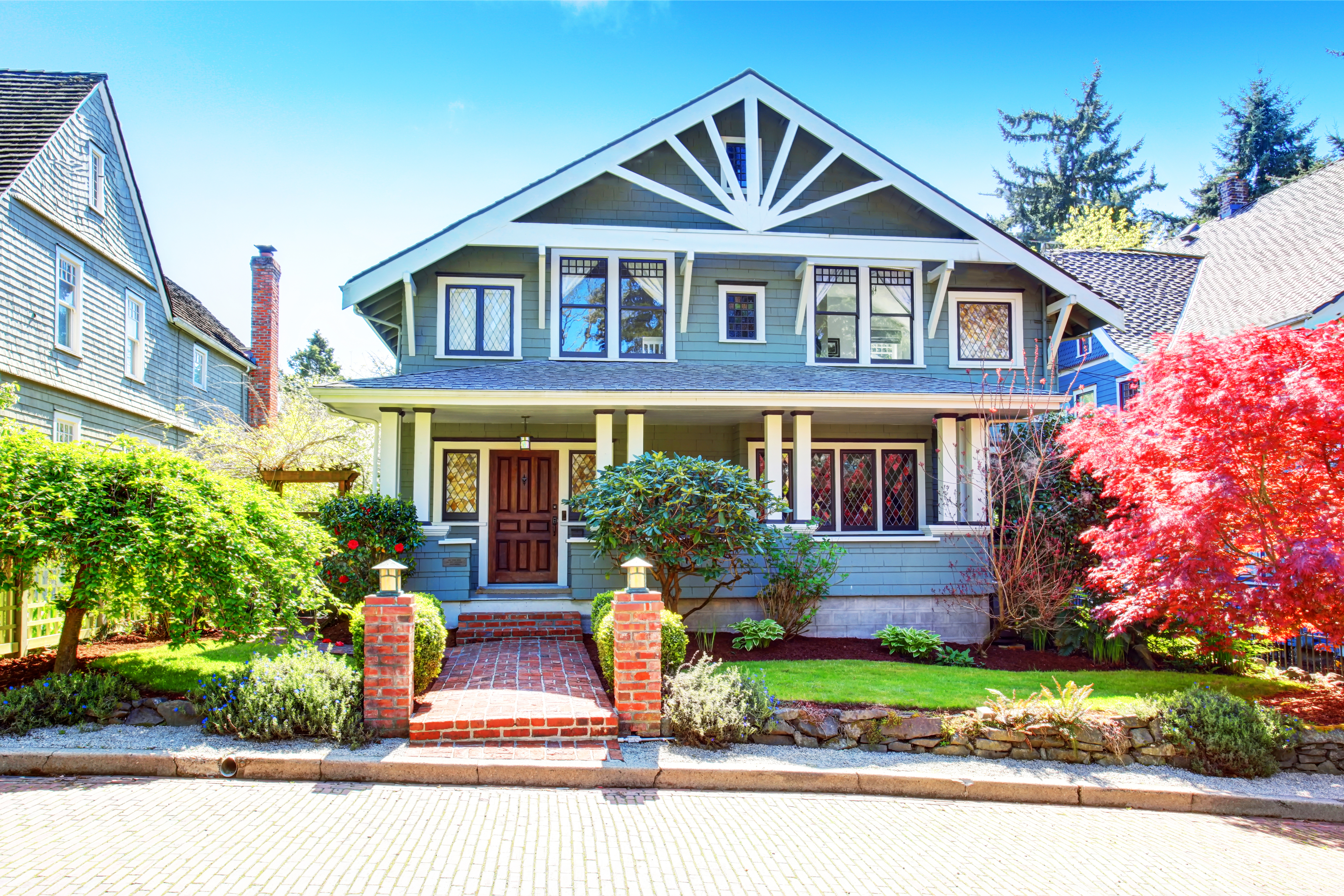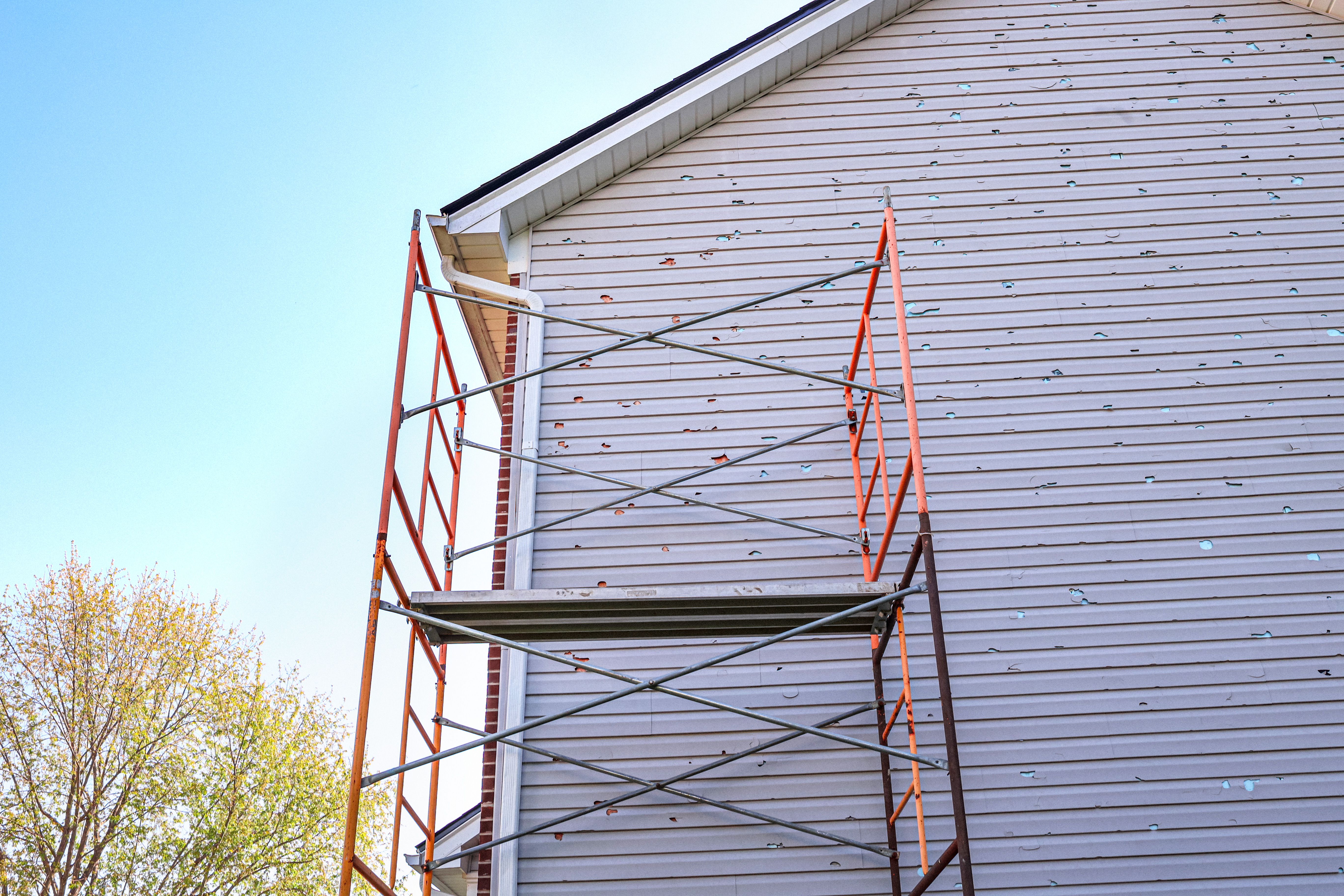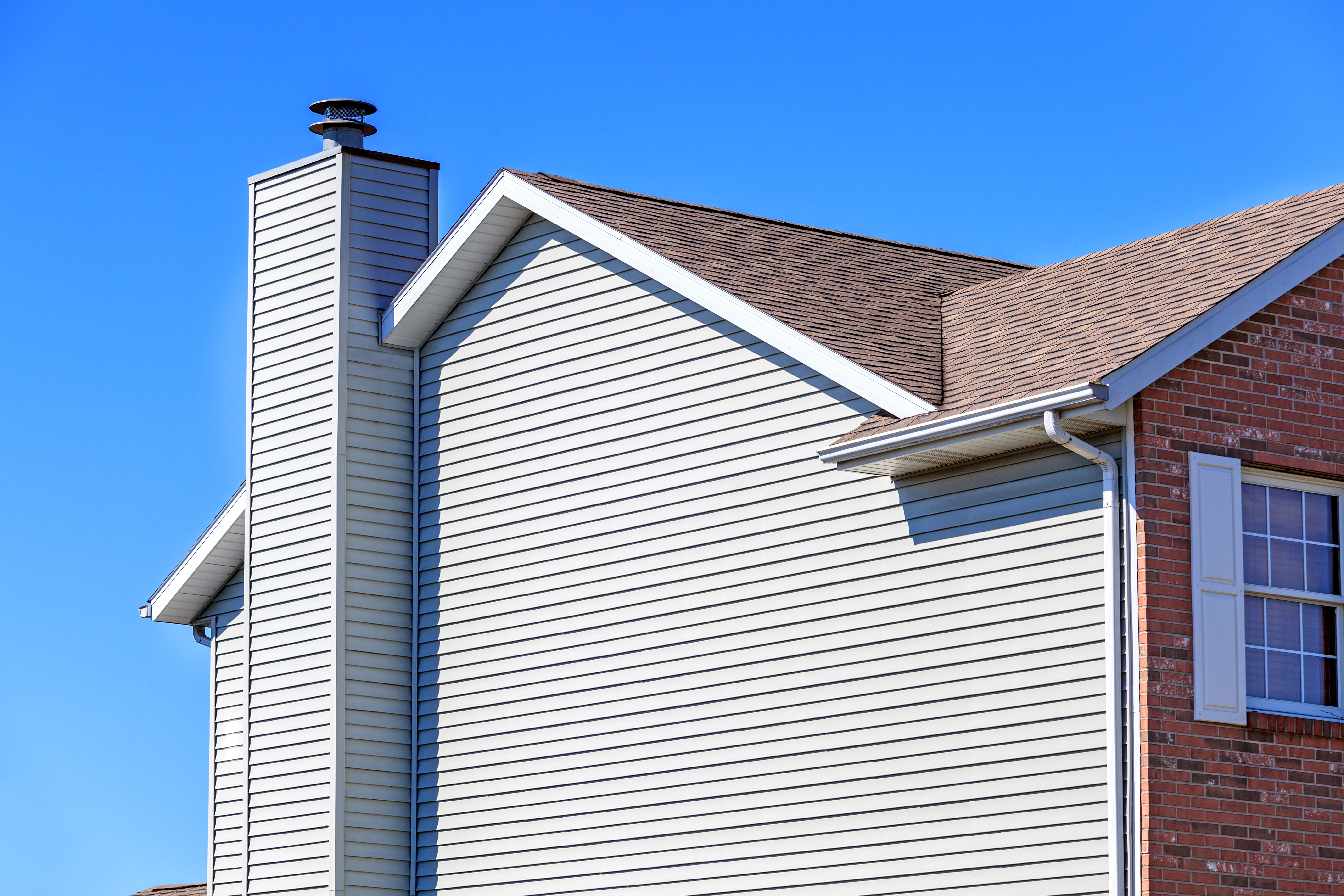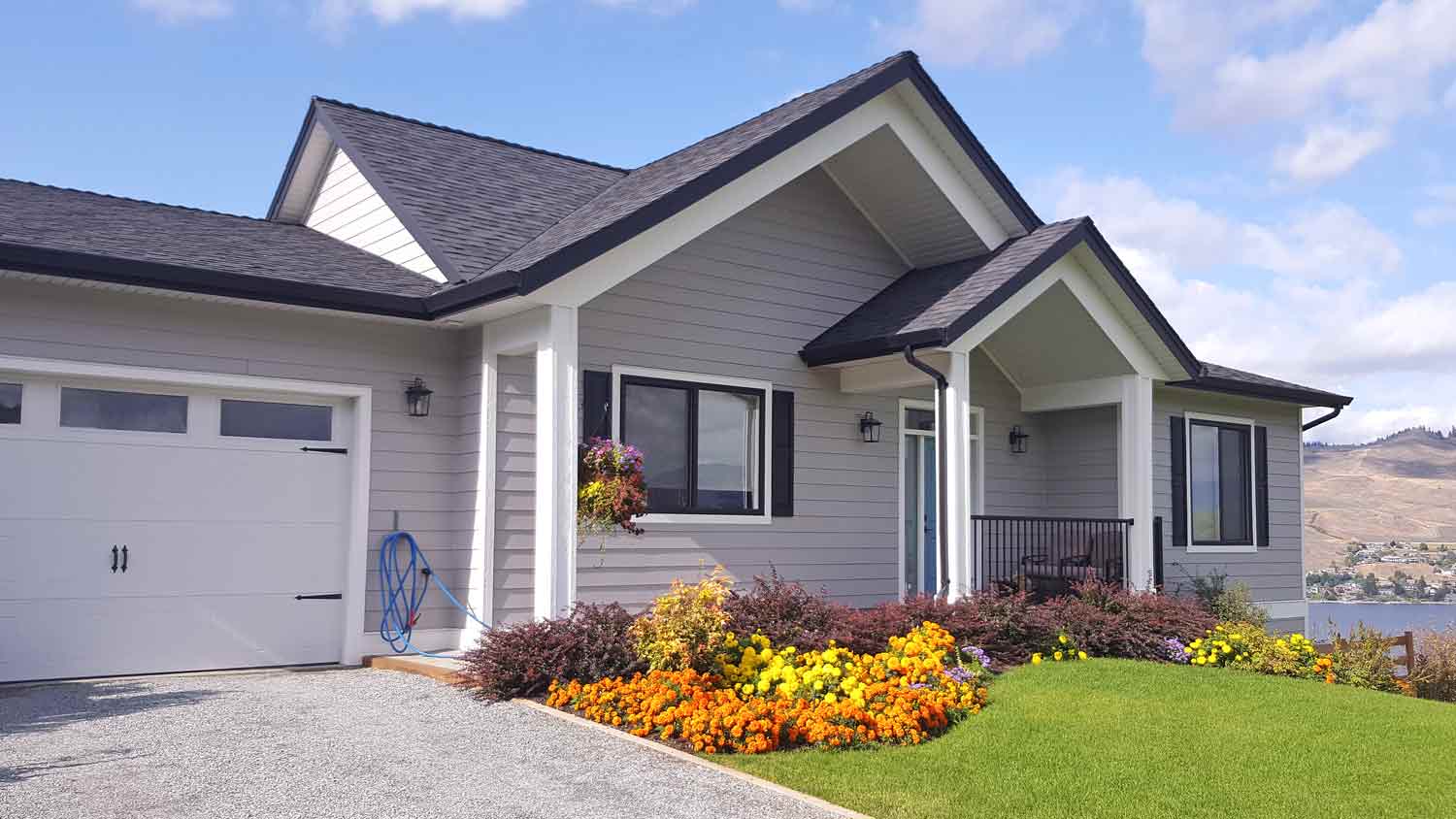
Fiber cement siding is durable, fire-resistant, and affordable. Learn more about fiber cement installation costs in Columbus, OH.
Siding repairs in Columbus cost $583 on average, with most homeowners spending between $212 and $972.


Siding repair costs in Columbus vary depending on the material, design, and damage.
Contractors charge extra for hard-to-access areas.
Homes in historic districts often face higher repair costs due to strict guidelines.
Siding repairs in Columbus cost $583 on average, but they can range from $212 to $972 depending on factors like your home’s size and siding material. From freezing winters to humid summers, Columbus homes can take a beating, so making siding repairs sooner rather than later can help you prevent costly long-term damage.
With its freeze-thaw cycles and storm-heavy summers, Columbus weather can be tough on siding. Repair costs in the area vary based on factors like your home’s size and shape, as well as what kind of siding material you have.
Your home’s size and shape can directly affect your siding repair costs. Larger homes have more surface area, which means more opportunities for damage and more material and labor required to fix it. Plus, one-story homes with straightforward designs are usually faster and more affordable to work on, while multi-story layouts or features like bay windows and decorative trim demand extra time and skill, which can increase your costs.
| House Size in Square Feet | Average Siding Cost |
|---|---|
| 1,000 | $1,000–$13,500 |
| 1,500 | $1,500–$20,250 |
| 2,000 | $2,000–$27,000 |
| 2,500 | $2,500–$33,750 |
| 3,000 | $3,000–$40,500 |
Material type is one of the biggest factors in siding repair costs. Some siding options, like fiber cement and engineered wood, are more expensive to fix due to higher material prices and the need for specialized tools and labor. Others may be cheaper upfront, but are more prone to damage in Columbus’s humid summers and harsh winters, leading to more frequent repairs over time. Historic neighborhoods can also drive up costs if you need to use specific materials to meet historic preservation standards.
| Siding Material | Cost per sq. ft. | Lifespan | Pros (Columbus) | Cons (Columbus) |
|---|---|---|---|---|
| Fiber Cement | $5–$14 | 50 years | Withstands Ohio’s humidity and temperature swings; fire- and pest-resistant; low maintenance | Heavy and labor-intensive to install, especially on multi-story homes |
| Engineered Wood | $1–$6 | 20–40 years | Affordable, wood-like look fits Columbus’s older neighborhoods, easier to install than natural wood | Susceptible to moisture if not sealed properly; Columbus’s humid summers can accelerate wear |
| Vinyl | $3–$12 | 20–40 years | Budget-friendly, low maintenance, holds up to seasonal changes | Can warp in extreme heat or crack in freezing temps; not ideal for historic districts |
| Wood | $1–$15 | 20–40 years | Offers a classic look for Columbus’s historic homes; customizable with paint or stain | High upkeep; prone to rot, warping, and insect damage in humid or wet conditions |
| Stucco | $7–$9 | 50+ years | Energy-efficient, good insulation during cold winters | Vulnerable to cracking from freeze-thaw cycles; moisture intrusion can lead to costly repairs |
| Brick Veneer | $3–$10 | 70–100 years | Durable and visually consistent with many Columbus neighborhoods; low maintenance | Heavy; repairs can be expensive if settling or moisture problems occur |
| Stone Veneer | $5–$11 | 20–75 years | Upscale appearance; durable when properly installed and sealed | Improper installation can trap moisture; higher upfront cost |
| Aluminum | $3–$6 | 20–40 years | Fire- and pest-resistant, won’t rust, performs well in wet weather | Dents easily; provides minimal insulation during cold Columbus winters |
Most Columbus homeowners need siding repairs every 3 to 7 years, depending on the siding material. The city’s humid summers and freezing winters can cause many materials to expand, contract, and degrade over time.
Wood siding usually needs the most frequent maintenance, while vinyl and engineered wood need it less often but are still prone to cracking or shifting. Fiber cement requires the least maintenance but should still be inspected every few years to catch early signs of wear before they become costly problems.
Many Columbus homes, especially in older neighborhoods, were built before current building codes, so removing existing siding can uncover surprises. Hidden issues like rotted sheathing, outdated insulation, or patchy past repairs are common and can drive up costs.
In some cases, older siding may also contain lead paint or asbestos, which requires professional removal. Columbus also has rules around proper disposal, especially for hazardous materials, so it’s generally a good idea to budget an extra 10% to 20% for unexpected issues that might show up once the siding comes off.
Complexity drives up costs, whether it’s the repair itself or the home’s design. Replacing a single cracked panel is relatively simple and affordable, but fixing multiple warped boards, hidden water damage, or improperly installed siding takes more time, skill, and money.
Architectural features, like bay windows and decorative trim, add another layer of difficulty. In Columbus’s historic neighborhoods, strict preservation rules can raise the costs even further, especially when repairs need to match the original materials and appearance.

Siding repairs in Columbus can get pricier when the damaged area is hard to reach. Multi-story homes or obstacles like overgrown landscaping, fences, or decks can slow down the job and require extra equipment like scaffolding or lifts. These access challenges are especially common in older neighborhoods with limited space between houses, and they often lead to higher labor costs.
Most Columbus contractors include standard cleanup in their siding repair quotes, which usually covers sweeping up the work area and disposing of common materials. But if the job involves heavy demolition and leaves behind bulk materials, you might be looking at increased cleanup costs.
Things like rotted wood, bulk siding waste, or outdated insulation may require separate disposal. And if lead paint or asbestos is found, licensed removal and special handling are legally required, which increases your costs.
In Columbus, design fees may come into play if your siding repair involves updating materials, altering your home’s exterior, or matching a historic style. This is especially common in historic districts and neighborhoods with active HOAs. For repairs like this, you may need input from a designer to ensure the work meets local guidelines. Depending on the level of customization and coordination, design fees can range from a few hundred to several thousand dollars.
The cost of hiring a siding pro can vary widely depending on the scope of the repair and who you hire. When budgeting for the repair, it’s helpful to account for things like labor rates and permit fees.
Columbus siding contractors generally charge between $30 and $70 per hour, or about $1 to $4 per square foot for repairs. Labor is often the biggest expense, especially for homes with multiple stories, detailed architectural features, or older materials that require careful handling. Contractors with experience working on historic properties or aging structures may charge a premium, but they’re often worth it to avoid costly errors and code violations.
In Columbus, you typically need a permit for siding repairs that involve replacing large areas, changing materials, or addressing structural issues. The standard permit fee is around $350 and includes one inspection. Smaller repairs are often considered routine maintenance and may not require a permit. If your home is in a historic district or subject to special zoning, you may also need a Certificate of Appropriateness, which can add extra review steps and increase your overall costs.
In Columbus, siding contractors need to register with the city and meet a few key requirements, including carrying liability insurance—typically at least $300,000 per person and $500,000 per occurrence—and submitting a $25,000 surety bond. These protections add to a contractor’s overhead, which can be reflected in the overall cost of your siding repair.
Columbus has a 7.5% sales tax that generally applies to siding materials but not labor. If your contractor itemizes materials and labor separately, you’ll only be taxed on the materials. But if they bundle everything into one price, it's worth asking how they're applying sales tax, since the full amount could end up being taxed depending on how the invoice is structured.
For large or very specific siding repairs in Columbus, you may need to bring in additional specialists beyond a standard siding crew:
Architect: If you’re working on a home in one of Columbus’s historic districts or trying to blend new siding with original materials, an architect can help ensure the design meets local guidelines. Their fees typically range from 5% to 20% of the total project cost.
Structural Engineers: If repairs uncover issues with your home’s framing, foundation, or other structural elements, you’ll likely need a structural engineer to assess the damage and sign off on repairs. Expect to pay between $350 and $800 for their services.
Asbestos Abatement Contractors: Some older homes in Columbus still have siding that contains asbestos or lead-based paint. If that’s the case, a certified abatement professional must handle removal, which usually costs between $1,200 and $3,300 depending on the extent.
Yes, siding repairs can increase your home’s value in Columbus, especially when they enhance its curb appeal or address visible damage that might turn off buyers. In older Columbus neighborhoods, repairs that preserve original architectural details or meet historic district guidelines can add even more value by keeping the home in line with local character and expectations.
Home is the most important place on earth, which is why Angi has helped more than 150 million homeowners transform their houses into homes they adore. To help homeowners with their next project, Angi provides readers with the most accurate cost data and upholds strict editorial standards. We survey real Angi customers about their project costs to develop the pricing data you see, so you can make the best decisions for you and your home. We pair this data with research from reputable sources, including the U.S. Bureau of Labor Statistics, academic journals, market studies, and interviews with industry experts—all to ensure our prices reflect real-world projects.
Want to help us improve our cost data? Send us a recent project quote to [email protected]. Quotes and personal information will not be shared publicly.
From average costs to expert advice, get all the answers you need to get your job done.

Fiber cement siding is durable, fire-resistant, and affordable. Learn more about fiber cement installation costs in Columbus, OH.

In addition to protecting against extreme Midwest temperatures, new siding in Columbus adds curb appeal. Learn about siding replacement cost in Columbus.

New vinyl siding adds value and curb appeal to homes in Columbus, Ohio. Learn about average vinyl siding installation costs in Columbus, Ohio.

Lap siding is a common siding style available in various materials. Learn what lap siding is, its pros and cons, and how much it costs.

Discover the pros, cons, and everything else you need to know about insulated vinyl siding.

Knowing the differences between fiber cement and vinyl siding can help you choose the right one for your home. Our guide explores these two siding choices.